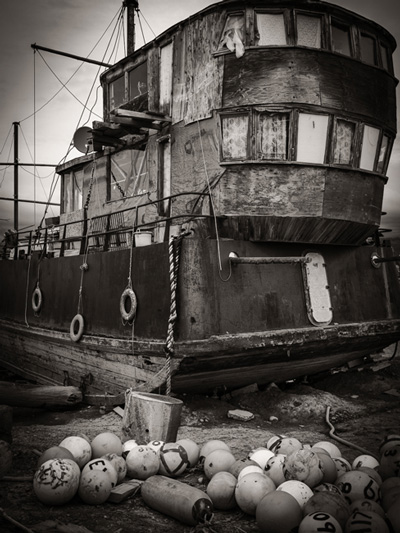
Image: Pongsatorn Sukhum
Pongsatorn Sukhum was on his way to becoming a professional photographer. A long-time camera enthusiast, he took a year off college while studying in the UK to work in a studio that shot advertising photography. He then moved into editorial photography, shooting for travel magazines and building up a collection of underwater stock images that combined his love of photography with his passion for Scuba diving. In the mid-nineties, his work was shown in a group exhibition in his native Thailand. Today, Pongsatorn runs an engineering business in Bangkok but his continued work in underwater photography, and in particular, his images of World War II wrecks off the coast of Thailand are an example of how talented enthusiasts can keep their professions while maintaining their passion for image-making and even contributing to the preservation of the subjects they love to shoot.
Pongsatorn now produces fine art prints of his photography which he sells through his website. But publications call him whenever they need images to complement their editorials on wrecks in the region and he is still commissioned occasionally for advertising work. If he’s not working on an engineering project, he’ll dive one or two weekends each month and when he’s not on the water, he’ll find time each week to process images and research ships.
Artistry Meets Expertise
That demand for professional imagery from a photographer who only works in the profession part-time continues for a couple of reasons. The quality of Pongsatorn’s photographs is certainly one factor. Pongsatorn may not be a full-time photographer but his images are professional quality. He shoots in black and white to convey the sense of being in an environment in which color has been stripped away by the water, and to convey the mood at the depths where the ships rest.
“I feel that the characteristics of high-speed b/w film faithfully capture the light and ambiance at these great depths,” he told us by email. “I also believe that entering the water loaded with b/w film is a mindset.”
The result is a collection of atmospheric shots in which the fragility and graceful lines of the diver are set against the solidity of a slowly decaying steel hulk placed in front of a backdrop of silty grays.
But the continued demand among buyers for Pongsatorn’s skills can also be put down to his expertise. Underwater photography is demanding. Photographers have to be skilled in diving as well as in image-making. They need to understand their equipment and the environment as well as the subject of the shoot.
“Underwater, we can’t change lenses, add filters, or replace batteries so advanced planning is required,” says Pongsatorn. “Familiarity with the layout of the wreck is crucial to avoid delays associated with orientation.”
Pongsatorn keeps a collection of construction blueprints related to the wreck he’s about to shoot, as well as sketches that he updates regularly. Before the dive, those plans are transferred to a waterproof slate for use underwater so that he’s not trying to communicate a new idea to a co-diver or assistant while they’re swimming. The choice of shots, too, poses a range of different problems. Wide angle images mean keeping other divers and their bubbles away from the scene long enough for Pongsatorn to get his shots. That’s not usually an issue when shooting wrecks that aren’t popular dive sites but for well-known locations, Pongsatorn usually pleads for a ten-minute head start. Before some shoots, he’s even asked the Thai Navy to cordon off a wreck for a day.
While underwater photographers don’t have the same daylight worries as landscape photographers, they do have to cope with other challenges. Weather conditions can restrict accessibility to remote sites to certain times of the year, and sediment raised by the actions of a swimming photographer can reduce visibility.
“This happens frequently as the wrecks are naturally on the sea bed (with the exception of the so-called vertical wreck) where there is a great deal of sediment just waiting to be disturbed,” says Pongsatorn. “Diver buoyancy control and proper finning techniques need to be practiced.”
Learn How to Fin
Often, the constraints of time and the limitations of depth mean that Pongsatorn can only make one or two dives to a low-lying wreck on any given day. Some dive profiles, he says, are so deep that he’ll only be able to stay at the site for as little as five minutes.
“As you can imagine, deep wreck photography is a very low-yield activity. However, these challenges make it exciting and create opportunities for some truly creative work.”
For other photographers looking to specialize in underwater photography, Pongsatorn notes that while no official training is required, there are numerous basic courses and workshops available that will explain how light behaves underwater and how to set up and look after equipment. Photographers who happen to live in tropical areas can start by photographing clown fish, he recommends, as they’re easy to find and tend to stay in one place. Once they’ve mastered finning and have control over their stability, photographers can pick a subject and study its behavior.
Most important though is to respect the environment in which you’re shooting. On his blog, Pongsatorn has highlighted campaigns for shark preservation and attacked dive operators who remove artifacts from the wrecks they visit.
“There are several operators who specifically set out to loot. It’s in their literature. They abuse the legal loopholes and lack of enforcement. It’s sad to see all these artifacts being hauled up day after day. These people need to be educated.”
Similarly, divers who venture into a wreck exhale bubbles which can get trapped below decks and under bulkheads. In time, these air pockets corrode the metal and exert an upward pressure on the metal plates, causing them to collapse, Pongsatorn warns.
It’s that kind of knowledge and that level of concern that combines with creativity and artistry to produce images that are attractive to buyers — both of art prints and for commercial use. Find a subject for which you feel passionate enough to want to study and understand completely, bring to it your photography skills, and you also won’t need to give up the day job to earn money from your photography.
Photopreneur – Make Money Selling Your Photos










 Yves Saint Laurent and Model Karen Mulder. Photo by: Helmut Newton
Yves Saint Laurent and Model Karen Mulder. Photo by: Helmut Newton

 Mario Testino at Burberry Fashion Show. Photo by: Chris Jackson
Mario Testino at Burberry Fashion Show. Photo by: Chris Jackson
You must be logged in to post a comment.